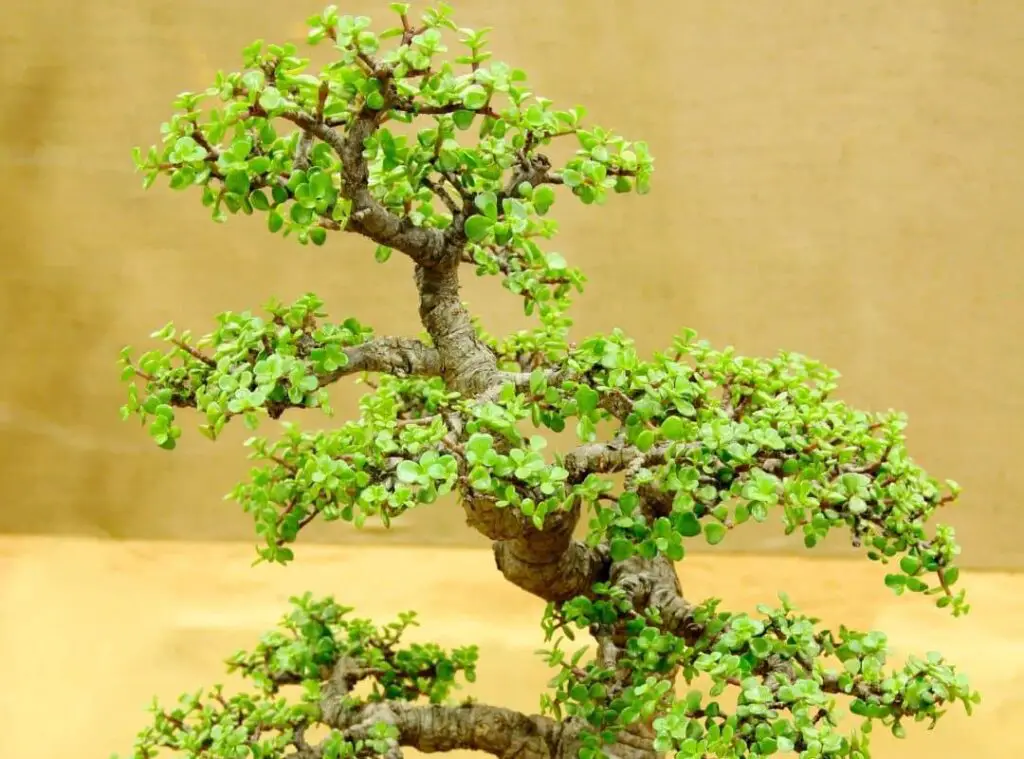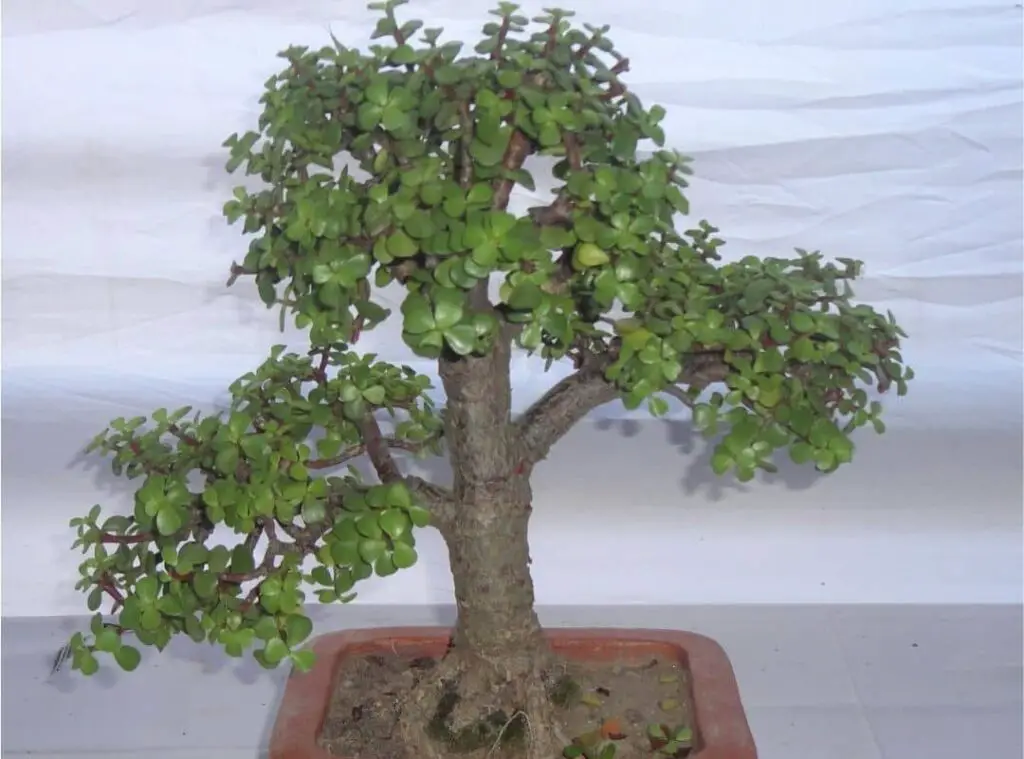Yes, elephant bush bonsai plants are pretty common in the world.
Elephant bush plants usually grow in hanging baskets or in elevated containers. Since they are succulent, they could withstand the hot and dry weather compared to the rest of other bonsai plants, such as maple, or other evergreen plants.
Most importantly, Elephant bush bonsai plants need minimum supervision from you.

How do you turn an elephant bush into a bonsai?
As explained in the beginning of the article, these plants can thrive in hot and dry weather. Elephant bushes have heart or round shaped leaves.
Besides that their stems are red brown in color. You could spot their leaves forming in four leaf covers. Those leaves are edible, and they would perfectly fit in as ingredients of salads.
- First and foremost, snip off a branch which is about 5-6 inches long ( 15-20 cm).
- Take several cuttings which have several branches on it .
- Next, obtain the cutting which doesn’t have any branches. Then, snip off the leaves of it while keeping only top part leaves available.
- You could do this manually.
- Next, trim the cutting’s bottom part in an angle manner.
- After that take the cutting which has branches on it and snip off the branches which are remaining on the bottom part of the cutting.
- Next make a cutting in the bottom part with an angle. Next allow them to wither and become dry.
- In the meantime, dig a hole in the planter with a chopstick and plant the cutting.
- Next keep on adding soil to make the cutting established. You could plant many cuttings in the same individual pot at the same time.
- I recommend not watering them until they form fresh leaves from the upper part of it.
- When they form fresh leaves, you may moisten the soil.
Elephant bush bonsai care
Sunlight requirement
Elephant bush bonsai plants should be located in a place where they can gain full sunlight preferably in the morning hours.
Ideal temperature level should be around 50 degrees Fahrenheit. When you grow them, make sure that they can fulfill their light requirement.
If they still run short of sunlight, you could grow them closer to grow lights. If they have got sufficient sunlight, you will see how they turn their leaves’ edges red.
Water requirement
Elephant bush bonsai have water conversations in their leaves. Hence, they can survive in the drought conditions and would require only a minimum water level.
Best is to let the plants wither between two watering sessions so that you can assure that you are not providing an excess amount of water for them.
These plants are quite responsive for over watering, hence ensure you water them in the right amounts.

Fertilizing requirement
To feed the elephant bush bonsai, they would thrive well with once a month feeding when they actively grow in seasons in spring to Autumn. A well-balanced fertilizer would go well with these plants.
Potting and repotting
How often you should repot depends on the size of the pot and tree species of your Bonsai.
We could repot elephant bush plants once every two years. You may repot them during spring. Simply all you have to do is to transplant them in a well-draining soil mix.
Usually many of the bonsai plants prefer a light watering right after you repot them whereas Elephant bush plants do not prefer water when you repot them.
Best is to wait for about one week’s time and then add water for them. That will avoid any potential fungal root rot.
How to prune Elephant bush plants bonsai
You should do pruning in such a manner where you do it so gently as they have water conserved in their branches and in their trunks.
If they become too heavy, chances are that they could fall from the excess weight. You should take your own time when pruning them and do it methodically.
When you prune them, it will help the plants to develop branches lower on the trunk.
Pests and Diseases
Elephant bush bonsai can resist many diseases and pest attacks.
However, if you water them well and expose them to sufficient sunlight, they will grow well without subjecting to any common bonsai diseases.
Elephant bush bonsai losing leaves
There are certain factors which cause the elephant bush plants to lose the leaves.
The reasons are: over watering, growing in poor quality soil, change in the growing conditions, lack of sunlight, rain, careless handling, and diseases etc.
If we further elaborate on the factors, over watering is one major factor which could contribute to this condition.
When you over water them, it will stop the plants from absorbing the sufficient oxygen levels. It will pave the way for fungal attacks which could cause leaves to drop.
Further under-watering would also cause the plants to shed the leaves. They do it to save the remaining water.. Hence it is critical that you water them properly without under watering or over watering them.
Besides from the aforesaid factors if you grow them in a poor draining soil mix , it could also result in leaves dropping in the plants.
As such best is to grow them in a readily available cactus soil mix or in a succulent soil mix.
Besides that, if you expose the plants to a drastic change in the growing conditions , careless handling , lack of sunlight may also cause these plants’ leaves to drop.
Last but not least, pests such as mealybugs, aphids and scales could also make them drop the leaves.

How to prune elephant bush bonsai plant
- You need to consider pruning specially when you are growing them as bonsai plants.
- To start off, you should first report them.
- Next water them at least two days prior to prune them.
- Select a container which is shallow and well draining.
- When you prune them you need to use a sterile knife and scissors for this.
- Next make a cutting closer to the trunk. Avoid just trimming them off having no idea of the desired shape you wish to have.
- Ideally you need to visualize them first and do it slowly.
- Ensure that you knock away the dead and the decaying plant parts first.
- Next if you can spot any etiolated plant parts, you may snip them off too.
- Trim whatever the leaves you can spot on the trunk.
- Moreover, if there are any deceased plant parts, remove them and dispose of them too.
- You may leave the short branches as they are so that you could have the desired shape of the plant you want to have.
- After that , you could snip the branch tips whilst allowing the branches to spill out. Next, trim the branches which have two pairs of leaves.
- Next, remove the leaves in the longer branches so that there will be leaves left only in the branch’s tips.
- Best is to leave about 2-4 leaves in the branch’s edges. Finally, use wire and shape the longer branches as you desire.
Can I use cactus soil for bonsai?
Cactus soil would be ideal to grow the bonsai as they have the same chaecstics as the bonsai soil.
In fact, they all comprise similar ingredients and have the same features with regards to water retention and draining .
However, ensure that you select the right cactus soil mix for the elephant bush bonsai though.
Can you bonsai other succulents?
Succulents such as Crassula ovata, Sedum, and Euphorbia trigona could be great picks for bonsai.
Besides that, some cacti types like cereus peruvianus monstrose and Opuntia imbricate would also be useful here.
Related questions
Can elephant bushes grow indoors?
Elephant bush would be great picks for indoor gardening. However, expose them for warmer temperature levels, bright sunlight levels though.
Is elephant bush the same as Jade?
Both Elephant bush and Jade plants have so many similar features. They have a closer resemblance with regards to the appearance of it. However, they are not related though.
Conclusion
Elephant bush plants have many benefits, and it is quite pleasing to watch them when they are fully grown.
All you need to do is to provide them with the optimal growing conditions and look after the plants well.
They are versatile plants and would grow to their fullest with minimum supervision from you. Hence it is a plant which is worth having !
Read Next : Elephant Bush Soil, Pot And Repotting (You Should Get To The Bottom) Elephant Bush Pruning Guide ( Prune For Better Look! ) 10 Elephant Bush Benefits (Can You Think More?)
